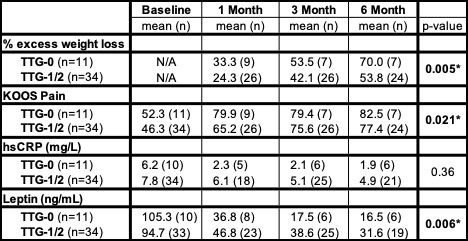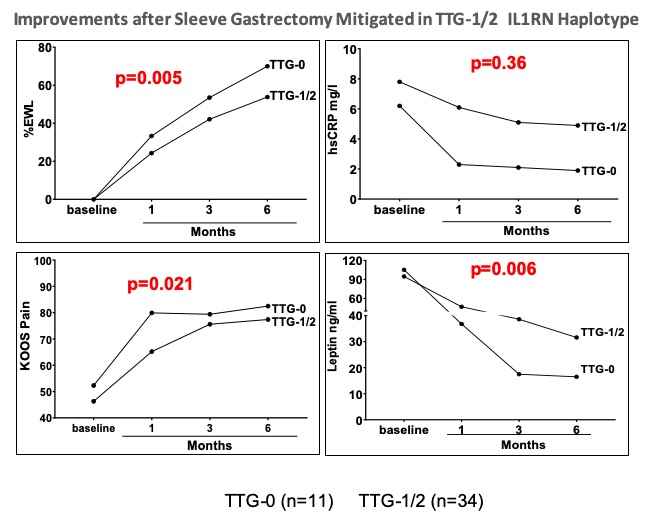Session Information
Session Type: Poster Session C
Session Time: 9:00AM-11:00AM
Background/Purpose: Symptomatic knee osteoarthritis (SKOA) patients with obesity who undergo bariatric surgery experience knee pain relief, though the reduced mechanical load explains only part of the improvement. A reduction in inflammatory biomarkers from adipose tissue may also impact pain. We previously identified an IL1RN haplotype (TTG; rs419598, rs315952, and rs9005) that associates with OA severity and inflammatory markers. We aimed to determine whether TTG distinguishes patients who lose more weight and have more significant decreases in inflammation with greater knee OA pain relief.
Methods: From 2013-2019 we enrolled patients ≥30 years old with BMI ≥30 kg/m2 and painful knee OA who planned surgical (sleeve gastrectomy, gastric bypass, or laparoscopic band) or medical weight loss (MWL) at Bellevue Hospital or NYU Langone Health. Patients with lupus, rheumatoid arthritis, or psoriatic arthritis were excluded. Weight-bearing knee x-rays assessed OA severity to confirm a Kellgren-Lawrence grade of at least 1 (scale 0-4). Participants completed the Knee Injury and Osteoarthritis Outcomes (KOOS) questionnaire and provided blood at baseline and 1, 3, 6, and 12 months. Patients were genotyped to determine whether they carried 1 or 2 copies of the TTG haplotype (TTG-1/2) or none (TTG-0). Sleeve was the most common weight loss intervention, therefore our analysis is focused on this surgical subset to minimize variable effects on weight and biomarkers.
Results: We enrolled 113 patients (95 F, 18 M) with painful knee OA prior to their weight loss intervention. The mean age, BMI, and KOOS pain at baseline were 50.3 ± 12.0 years, 44.8 ± 8.9 kg/m2, and 48.4 ± 18.2 (0-100, with 100 = no pain). Of 113 patients, 48 underwent sleeve, 20 bypass, 9 laparoscopic banding, 12 did not have the surgery, and 24 pursued medical weight loss. The 77 who completed surgery had a mean % excess weight loss (%EWL) of 51.7 after 6 months, with significant decreases in hsCRP (4.4 mg/L) and leptin (32.8 ng/dL), and mean KOOS pain improvement of 22.4 (MCID= 16.7). The corresponding changes for patients who tried various MWL regimens were modest at best. We obtained the IL1RN haplotype for 45 of the 48 sleeve patients, and found 34 (70.8%) carried the TTG-1 or TTG-2 haplotype while 11 were TTG-0 (with similar baseline age, BMI, and KOOS for the two groups). At each follow-up time point through 6 months (Figure 1), TTG-1/2 patients had more difficulty losing weight than the TTG-0 group (p< 0.005 by ANOVA), with corresponding smaller reductions in hsCRP (p=0.36) and leptin (p=0.006). TTG-1/2 carriers also reported less KOOS pain relief relative to the TTG-0 group (p=0.021), markedly at 1 and 3 months with some improvement later (Table 1). All of these findings held true when only plotting data only from the 23 patients (18 TTG-1/2, 5 TTG-0) who completed each of the followup visits.
Conclusion: SKOA patients with obesity achieve marked excess weight loss, reductions in inflammatory mediators, and knee pain relief with bariatric surgery. The subset of patients with the TTG-0 IL1RN haplotype demonstrated more significant and/or rapid improvement in each of these outcomes, suggesting a potential predictor of which OA patients will have a more successful response to bariatric surgery.
To cite this abstract in AMA style:
Samuels J, Bomfim F, Attur M, Ren-Fielding C, Parikh M, La Rocca-Vieira R, Abramson S. IL1RN Polymorphism Predicts Weight Loss, Inflammatory Biomarker Changes and Knee Osteoarthritis Pain Relief After Bariatric Surgery [abstract]. Arthritis Rheumatol. 2020; 72 (suppl 10). https://acrabstracts.org/abstract/il1rn-polymorphism-predicts-weight-loss-inflammatory-biomarker-changes-and-knee-osteoarthritis-pain-relief-after-bariatric-surgery/. Accessed .« Back to ACR Convergence 2020
ACR Meeting Abstracts - https://acrabstracts.org/abstract/il1rn-polymorphism-predicts-weight-loss-inflammatory-biomarker-changes-and-knee-osteoarthritis-pain-relief-after-bariatric-surgery/


